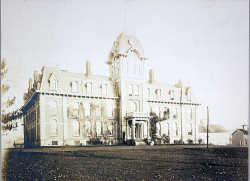Chautauqua County House
| Chautauqua County House | |
|---|---|
 | |
| Established | 1831 |
| Opened | 1833 |
| Closed | 1961 |
| Current Status | Demolished |
| Building Style | Single Building |
| Location | Dewittville, NY |
| Alternate Names | |
History[edit]
In 1831 the Chautauqua County Board of Supervisors purchased 90 acres of land in Dewittville for $900. In 1832 he County contracted with George Hall to construct a house to accommodate "at least 100 paupers." The building was described as "a substantial brick county-house, 94 feet long & 32 feet wide" and cost $2400. By 1833, the cemetery for the poor farm was established. The poor farm became a refuge for the country's poor, lame, insane, blind, sick, abandoned, and abused. Residents were housed, clothed, fed, and cared for by a resident administrator and his family. No separate accommodations were provided for the sick, and residents helped to monitor and care for each other. In 1846 additional acreage was purchased, in 1850 a second building was constructed to house the insane, and another building was added in 1857. In 1858, the weekly expense for supporting each resident was $.78, the value of the labor of the residents was $2524, and the expenses associated with the poor farm were $5094. The number of paupers relieved or supported through the poor farm was 4106. In 1867 a new three-story building for the insane was erected at the cost of $17,965. A doctor visited the residents daily, and made special visits when needed. In 1869 the doctor's annual salary was $225.
From 1833 until 1858, over thirty children were reported yearly as residents of the poor farm. Some children were born there, some were vagrants, and some arrived with their parents. Children between the ages of five and sixteen were to be schooled just as any child attending a common school in the state. In 1961, the County Home was relocated to a new facility erected at Dunkirk, and the Dewittville property (except the cemetery) was sold.
Cemetery[edit]
Beginning in 1864, graves were marked with rectangular numbered stones, and later with round numbered stones. Records kept at the Chautauqua County Home have made it possible to identify approximately 250 individuals who were interred at the cemetery. In 1991, a group of volunteers began clearing the cemetery property to locate all existing markers. The markers were placed in close proximity to their original locations.